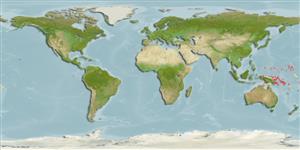>
Acanthuriformes (Surgeonfishes) >
Siganidae (Rabbitfishes)
Etymology: Siganus: Latin, siganus = a fish, rabbit fish; by the similarity of the nose (Ref. 45335).
Environment: milieu / climate zone / depth range / distribution range
Sinh thái học
Biển Cùng sống ở rạn san hô; Mức độ sâu 1 - 15 m (Ref. 37816). Tropical; 15°N - 15°S, 135°E - 159°W
Western Pacific: Solomon Islands, Papua New Guinea, Pohnpei, Kosrae, and Guam.
Bộ gần gũi / Khối lượng (Trọng lượng) / Age
Maturity: Lm ? range ? - ? cm
Max length : 33.5 cm FL con đực/không giới tính; (Ref. 107958); common length : 25.0 cm TL con đực/không giới tính; (Ref. 9813); Khối lượng cực đại được công bố: 824.00 g (Ref. 107958)
Các tia vây lưng cứng (tổng cộng) : 13; Các vây lưng mềm (tổng cộng) : 10; Tia cứng vây hậu môn: 7; Tia mềm vây hậu môn: 9; Động vật có xương sống: 23. Body is bronze, with bluish spots on the head and anterior portion of the body. These spots join in the posterior portion to form vermiculating patterns. Preopercular angle 98°-102°; strong scales covering cheeks with 9-11 rows deep below center of orbit; midline of thorax scaled, pelvic ridges without scales. Low rim of anterior nostril bearing a minute, pointed peak posteriorly. The spines are stout, blunt and venomous. S. randalli is similar to S. vermiculatus but is spotted on the head and front of the back (Ref. 37816).
Adults inhabit coral reef areas with sand and coral rubble, down to at least 15 m. Juveniles found in mangroves (Ref. 9710). Adults occur in schools of 10 to 20 or more and feed on algae growing on compacted pavement areas (Ref. 9813).
Life cycle and mating behavior
Maturities | Sự tái sinh sản | Spawnings | Egg(s) | Fecundities | Ấu trùng
Woodland, D.J., 1990. Revision of the fish family Siganidae with descriptions of two new species and comments on distribution and biology. Indo-Pac. Fish. (19):136 p. (Ref. 1419)
IUCN Red List Status (Ref. 130435)
Threat to humans
Venomous
Human uses
Các nghề cá: Các nghề cá là sinh kế; Nuôi trồng thủy sản: thực nghiệm
Các công cụ
Special reports
Download XML
Các nguồn internet
Estimates based on models
Preferred temperature (Ref.
123201): 28.7 - 29.5, mean 29.1 °C (based on 328 cells).
Phylogenetic diversity index (Ref.
82804): PD
50 = 0.5000 [Uniqueness, from 0.5 = low to 2.0 = high].
Bayesian length-weight: a=0.01479 (0.00801 - 0.02733), b=3.05 (2.89 - 3.21), in cm total length, based on LWR estimates for this species & Genus-body shape (Ref.
93245).
Mức dinh dưỡng (Ref.
69278): 2.0 ±0.00 se; based on food items.
Thích nghi nhanh (Ref.
120179): Chiêù cao, thời gian nhân đôi của chủng quần tối thiểu là dưới 15 tháng (Preliminary K or Fecundity.).
Fishing Vulnerability (Ref.
59153): Low to moderate vulnerability (27 of 100).
Nutrients (Ref.
124155): Calcium = 38.2 [18.7, 89.5] mg/100g; Iron = 0.675 [0.317, 1.554] mg/100g; Protein = 18.5 [17.0, 20.0] %; Omega3 = 0.094 [0.049, 0.188] g/100g; Selenium = 19.1 [7.5, 48.9] μg/100g; VitaminA = 32.3 [7.4, 131.7] μg/100g; Zinc = 1.39 [0.54, 2.95] mg/100g (wet weight);
